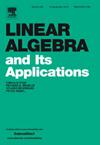关于无穷图的可因式性
IF 1.1
3区 数学
Q1 MATHEMATICS
引用次数: 0
摘要
如果G、H和K分别存在邻接矩阵A、B和C,则图G通过矩阵积被分解为图H和图K,使得A=BC。最近,Maghsoudi等人证明了完全图Kn当且仅当n=4k+1可被分解。在本文中,我们证明,与有限情况相反,(可数)无限完全图允许通过矩阵积进行因式分解。此外,他们还证明了完全二部图Km,n当且仅当m和n都是偶数时具有因数分解性。我们将此结果推广到无限完全二部图Km,n上,即:无限完全二部图允许被分解当且仅当有限部分(如果存在)的大小为偶。最后,我们证明了n维网格允许所有n≥2的分解。本文章由计算机程序翻译,如有差异,请以英文原文为准。
On the factorability of infinite graphs
A graph G is said to be factorized into graphs H and K via a matrix product if there exist adjacency matrices A, B, and C for G, H, and K, respectively, such that . Recently, Maghsoudi et al. proved that the complete graph admits a factorization if and only if . In this note, we show that, in contrast to the finite case, the (countably) infinite complete graph admits a factorization via a matrix product. In addition, they showed that the complete bipartite graph has a factorization if and only if both m and n are even. We extend this result to the infinite complete bipartite graph , namely: the infinite complete bipartite graph admits a factorization if and only if the size of the finite part (if it exists) is even. Finally, we show that the n-dimensional grid admits a factorization for all .
求助全文
通过发布文献求助,成功后即可免费获取论文全文。
去求助
来源期刊
CiteScore
2.20
自引率
9.10%
发文量
333
审稿时长
13.8 months
期刊介绍:
Linear Algebra and its Applications publishes articles that contribute new information or new insights to matrix theory and finite dimensional linear algebra in their algebraic, arithmetic, combinatorial, geometric, or numerical aspects. It also publishes articles that give significant applications of matrix theory or linear algebra to other branches of mathematics and to other sciences. Articles that provide new information or perspectives on the historical development of matrix theory and linear algebra are also welcome. Expository articles which can serve as an introduction to a subject for workers in related areas and which bring one to the frontiers of research are encouraged. Reviews of books are published occasionally as are conference reports that provide an historical record of major meetings on matrix theory and linear algebra.

 求助内容:
求助内容: 应助结果提醒方式:
应助结果提醒方式:


